EASTHAM — For at least the last couple of hundred years, the boulder near Coast Guard Beach known as Doane Rock has been a popular spot for rock climbers and rock sitters. So, word spread quickly when, for seven days in May, a sign in front of the rock announced: “Notice Do Not Climb on Doane Rock.”
eastham
HOUSING
Truro and Eastham May Limit Short-Term Rentals
‘Fractional ownership’ arrangements could also be banned by voters
Truro and Eastham are each considering town meeting articles that would limit how many short-term rental properties one person or corporation could legally own and that would ban “fractional ownership” of residential property outright.

At a public forum on March 4, Truro officials gave an overview of that town’s articles and answered questions.
The first article, which does not yet have a number because it has not been inserted in Truro’s town meeting warrant, would prohibit corporations from holding short-term rental certificates and would allow LLCs, S corporations, and trusts to hold them only if they disclose all of their human owners at town hall.
A second draft article would limit the number of short-term rental certificates any one owner could have to two. Current owners of three short-term rentals would be “grandfathered in” and allowed to continue operating, but owners of four or more would be allowed only to continue with three.
A third draft bylaw would prohibit fractional ownership arrangements of residential property in which the ownership shares are sold to strangers on the open market, as facilitated by companies such as Pacaso and Lifestyle Asset Group.
Short-term rentals are defined (and taxed) under state law as offering stays of fewer than 30 days.
The Lexvest Group, which is based in Maynard, currently offers three single-family homes and three cottages on Shore Road as short-term rentals on the website VRBO.
The company also owns the Prince of Whales cottage colony, which has 17 units, and the Truro Beach Cottages, which has 11. Those rentals are booked through their own websites.
Truro had 459 registered short-term rentals last season, Town Manager Darrin Tangeman told the Independent. The municipal services company Avenu, which offers software that can “scrape” a variety of short-term rental listing sites to find unregistered listings, told Tangeman there were another 27 properties that were not registered with the town.
The draft articles say that their “purpose and intent” is to “protect the time-honored tradition of home rentals in Truro” while also limiting “the conversion of residential units to short-term rentals,” which it says has had a “deleterious effect” on the year-round rental stock.
According to Truro’s draft Housing Needs Assessment and Production Plan, only 15 percent of the town’s occupied housing stock are rental units, which makes the town a “rental desert.”
Considering Truro’s total housing inventory instead of just the occupied units, only 5 percent of the units are occupied by renters, according to the Cape Cod Commission. Twenty-five percent of Truro’s housing units are occupied by their owners, and the remaining 70 percent are either used seasonally or are entirely vacant.
The percentage of Truro’s housing that is fully occupied is lower than in any other town on Cape Cod, according to the commission, and the median sale price for a single-family home is $1.4 million, among the highest on the Cape.
The affordable housing development at Sally’s Way has 16 year-round rentals — and more than 200 families on a waiting list.
Select board chair Kristen Reed said that the number of registered short-term rentals one owner could hold has not been finalized. “The number two could change if that was the will of the people,” Reed said at the March 4 forum. “It could be three. It could be more.”
Forum attendees had questions about the fractional ownership article and how it might affect longtime friends who own property together. Lee Swislow referred to “chosen family” to describe those relationships and said the bylaw’s language about “unrelated persons” might exclude people.
Tollie Miller made a similar point. “For about 25 years, I’ve owned a house in Truro with three of my closest friends, two of whom are married to each other,” Miller said. “I don’t want to discover that because we’ve done this for all these years together — because we could never afford to have a place to share otherwise — that it’s going to get us into trouble.”
Anne Greenbaum, vice chair of the planning board, was moderating the forum; she said that the issue deserved attention. “First of all, you all would be ‘grandparented in,’ but second of all, we need to figure out how to integrate that issue of chosen family,” Greenbaum said.
A ‘Proactive’ Ban
Eastham’s Task Force on Zoning and Regulation recommended both a ban on fractional ownership and a per-owner cap on short-term rentals to the select board. Though the town reports that it currently has no homes under fractional ownership, task force chair Mary Nee said the ban is “a proactive response” to the possibility of single-family homes being bought up in investment schemes.
“This is the first year we’ve looked at fractional ownership as a task force,” said Nee. The select board had asked the task force to examine the subject after Provincetown and Tisbury passed their bans last year.
Eastham’s year-round rental vacancy rate is “virtually zero,” the task force found. Provincetown’s assistant town manager Dan Riviello and community development director Tim Famulare discussed Provincetown’s new bylaws with the task force on Dec. 5.
Nee said that Eastham is especially vulnerable to investors buying up the housing stock because property values are lower than those in nearby towns. Eastham’s median single-family home price was $779,500 in 2023, according to the Cape Cod and Islands Association of Realtors, whereas Wellfleet’s was $965,000, and the median in Orleans was $1,222,500.
“In terms of investment opportunities, we as a community are very attractive,” Nee said.
Select board member Gerry Cerasale raised concerns that groups of friends would not be able to share homes or that the ban would complicate divorce proceedings. Nee assured him that the ban would apply only to corporate entities.
Eastham’s proposed short-term rental bylaw would require corporations to name their human owners, as in Truro’s proposal and Provincetown’s bylaw, and would cap the number of short-term rentals any one person could own or operate at two.
The current draft of the bylaw does not include a “grandfather” clause for people who own more than two, however. Instead, a person who currently owns or operates three short-term rentals would need to choose two that would continue to operate.
The proposed bylaws will be discussed at a public hearing of the planning board on March 20, after which the select board will make an “ultimate determination” on the final draft of the article before the warrant is finalized in early April.
Town Manager Jacqui Beebe will then hold a public meeting on all of the warrant articles ahead of town meeting on May 6.
BUILDING EASTHAM
This Old Eastham House: The Lobster Shanty
Research on a property’s past turns up a classic Cape Cod tale
EASTHAM — With its white wooden shingles, lobster traps, and sunny yellow awnings, the Lobster Shanty on Route 6 evokes the Cape Cod that Patti Page sang about in her 1957 classic “Old Cape Cod.” The decor, however, is from the 1980s.
That’s when the late Daniel Delgizzi, an off-Cape real estate investor, bought the property. He had, since the late 1950s, been buying up property on the Cape and moving old homes to his newly acquired lots.
The Shanty’s past came into view during an investigation of Delgizzi’s legacy. Today his properties, managed by his son David of Weston, mainly supply substandard housing for many in the region’s workforce.
In 2020, the Independent reported the Delgizzis owned nearly 100 units of rundown housing on Cape Cod — including some 60 units in Truro and 10 in Eastham, though two were taken by the town the following year because of unpaid tax bills dating as far back as 2014.
David Delgizzi could not be reached for comment.
But before the Delgizzis came along, the place really was an old Cape Cod eatery. Charles and Norma Chase opened the Hillside Restaurant in 1947, according to their daughter, Nancy Rutledge of Florida.
Charles, who was known as Buddy, was a born entrepreneur. He started out selling fruit, then eggs, and, later, chicken pies at a stand on nearby land owned by his parents, Leslie and Mabel Chase, according to Rutledge. The Chases’ 1820 farmhouse stood at 40 Salt Pond Road.
Despite rumors that a colonial-era tavern for pirates and mooncussers once stood at this spot, it appears that Buddy Chase was the first to operate a business here, said Rutledge. “He would sell anything,” said Rutledge. “He wanted to sell Cape Cod air in a can. He talked about that a lot.”
Out of the fruit and egg stand, Buddy built the Hillside into the kind of diner that had hamburgers, ice cream, and cake displayed under a glass dome on the counter, said Marca Daley, the archivist for the Eastham Historical Society and Rutledge’s childhood friend.
When the Cape Cod National Seashore was set to level the hill by the highway around 1961 to build the visitor center across Route 6, Buddy bought a house with a gambrel roof that stood on the fated hill and had it moved across the highway to expand his business.
He eventually opened a souvenir shop along with a motel with seven units and one apartment — and then a bike rental business, which still exists today. It is now called the Little Capistrano Bike Shop and is run by his daughter, Melissa Ayala.
Buddy created the small motel, now occupied by Delgizzi’s restaurant staff, from a two-story heated chicken coop that he had built years earlier as part of a 4-H project, Rutledge said.
The Hillside took on a new dimension when Eastham, the last dry town on Cape Cod, began to allow alcohol sales in 1961. This proved very profitable at first.
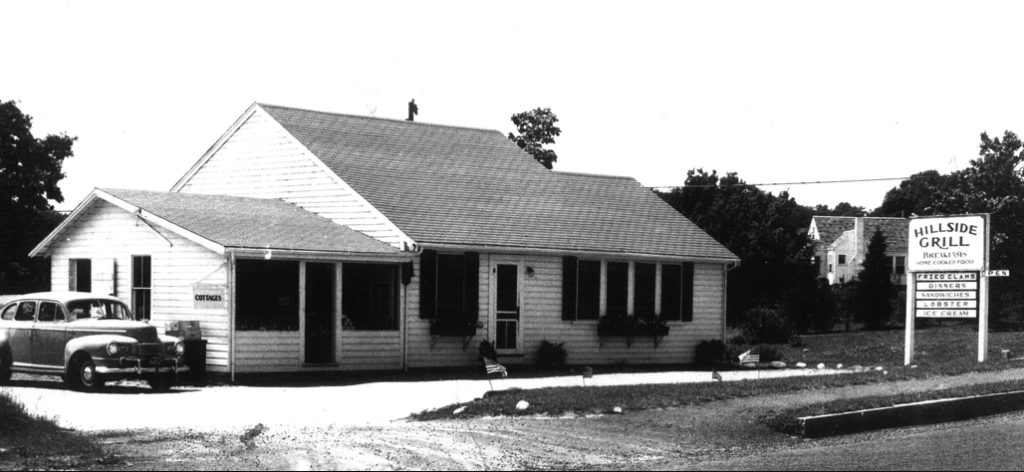
Rutledge said she learned to push alcohol long before she could legally drink it, to improve the business profits and her own tips. She said her parents also gave her a stool and taught her to operate the cash register because they “only wanted family touching the till.”
Mark Herman, a volunteer at the historical society, said the Hillside was quite a watering hole in the 1970s, for better and for worse. One man went to drink there after work with such regularity, Herman said, that his wife would deliver his dinner to the bar.
Buddy’s hard drinking with his friends at the Hillside caught up with him, Rutledge said. He stopped paying taxes on the Hillside, and it was eventually taken by the government, Ayala said. When he died at 60 in 1988, he left two former wives, five children, and a girlfriend. His wives, Norma and Kathy, became close friends and traveled together for years. “They had a lot in common,” Ayala said.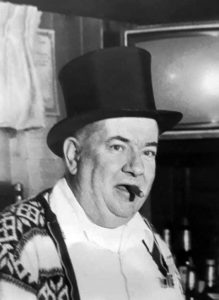
The Chase farmhouse originally owned by Mabel and Leslie Chase at 40 Salt Pond Road is now owned by Ayala and her husband, Mark. Both their house and the Delgizzis’ restaurant are in Eastham’s Old Town Centre National Register District, which comprises about 40 acres around Salt Pond and Locust roads, according to the U.S. Dept. of the Interior. The former town hall, now a private home, and former Eastham Grammar School, now a museum, are also in that area.
Take a Hike
The Eastham Conservation Foundation and Harwich Conservation Trust are co-sponsoring two guided walks in Eastham with historian Don Wilding on Saturday, May 15th. From 10 a.m. to noon, walk along the Nauset Marsh Trail and learn about historic storms, shipwrecks, and rescues. Then, from 1 to 3 p.m., learn about Henry Beston’s The Outermost House with a walk overlooking Nauset Marsh and “the Great Beach.” Registration is $20 at harwichconservationtrust.org.
Free Senior Workshops From Castle Hill
The spring session of Truro Center for the Arts at Castle Hill’s “60+” program begins this week. The free virtual workshops are open to residents of Provincetown, Truro, Wellfleet, Eastham, Orleans, Chatham, Harwich, and Brewster who are 60 years of age or older.
Vicky Tomayko teaches “Relief Printmaking in the Home Studio” on Tuesdays and Thursdays, 10 a.m. to noon, from April 13th to 29th. Students will learn how to make woodcuts, linocuts, and collagraphs. If cooking is more your thing, Katherine Alford, former vice president of Food Network’s test kitchen, teaches a workshop on Thursdays, 3 to 5 p.m., from April 22nd to May 20th, skipping May 6.
Sign up for the lottery at castlehill.org, or by calling 508-349-7511. Participants will be notified of admittance on Friday, April 9th.
Covid Relief Fund Recipients Announced
The Mass. Cultural Council has announced the recipients of the Covid-19 Relief Fund. It awarded grants of $1,500 to 781 artists, humanists, and scientists, $1,171,500 in total.
Twenty were from the Outer Cape. In Provincetown: visual artists Ramón S. Alcoléa, Karen Cappotto, Anastasia Egeli, Akiko Jackson, Chet Jones, and Gaston Lacombe; comedian Kristen Becker; multidisciplinary artist Andrew Fitzpatrick; filmmakers James Kubesch and Fermin Rojas; and, for theater, Robert DiVincenzo, Christopher Kosiavelon, and Michael Sottile.
In Truro: visual artist Donna Mahan and, for multidisciplinary arts, Stephanie Rein and Vanessa Vartabedian.
In Wellfleet: visual artists Megan Hinton and Julia Salinger.
And, finally, in Eastham: musician Billy Hardy. Congratulations to all.
STEEPLE CHASE
Chapel in the Pines Has Its Crowning Moment
Community preservation funds and private donations paid for renovation
EASTHAM — The Chapel in the Pines renovation was completed last Saturday as George Koeber and Paul Collins installed the final piece of the project — a copper steeple cap. The drawing for the piece was made by Ruben Valenzuela of Eastham’s Peter McDonald Architect firm, based on an old photo from the Eastham Historical Society. It was fabricated by Cape Cod Copper in Lakeville.
GRAVEYARD SHIFT
Turnip Time in Eastham
The lowly crucifer and its legendary local growers
EASTHAM — As the nights chill, the leaves fall, and the holidays approach, our thoughts turn to, yes, the turnip — that ancient crucifer that has, for too long, been relegated to the lowly status of livestock feed and staple for the poor. But don’t tell that to the folks in Eastham who have elevated their local turnip to celebrity status, honoring the deliciously sweet, white-fleshed, open-pollinated heirloom with its own festival.

Eastham has seen its share of change over the last century, but one thing that hasn’t changed is the Eastham turnip. Because its single seed line “breeds true,” producing offspring of the same variety, today’s turnip has inherited all the traits of its parents, grandparents, and great-grandparents. If our own ancestors could return for a family supper, their Eastham turnip would taste just the way they remember it.
The origin of Eastham turnips seems to be another Cape Cod mystery. As early as 1875, Eastham, the most agricultural of the Outer Cape towns, was the third largest producer of turnips in Barnstable County. In January 1884, the Barnstable Patriot reported that, during one week, 1,200 bushels — a bushel weighing about 55 pounds — had been shipped by train from Eastham to Boston. In 1895 the Yarmouth Register noted that J.B. Steele and George M. Harding were expecting to have the finest lot of turnips — 3,000 bushels — of any farm in Eastham. By 1905, Eastham ranked first in the county for turnip production.
A 1911 story in the Sandwich Observer mused that the “happy and contented community” of Eastham, with a population of 518, was running smoothly on a total appropriation of only $3,470, thanks in part to its asparagus crop and its famous Eastham white turnips.
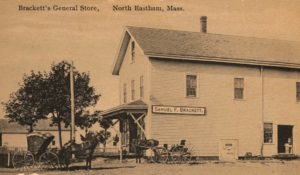
How to explain the success and magical flavor of these tandem crops, asparagus — known as “grass” — picked in the spring, and turnips pulled in the fall? Was it the quality of Eastham’s sand, said to be particularly suited for both crops, and, perhaps, some peculiarity of the Cape atmosphere? By the 1920s, hundreds of acres were devoted to the two crops and by the early 1930s, the heyday of turnip production, upward of 50,000 bushels of turnips were marketed annually, a portion of the harvest often buried in pits and covered with seaweed to wait for higher prices in the spring.
If the Eastham turnip can boast a resilient ancestral line, so could one of Eastham’s turnip-growing families, the Bracketts, whose turnips are said to be the progenitors of today’s Eastham root. Through the marriage of William Brackett to Sarah Hopkins, the family was descended from Mayflower passenger Stephen Hopkins. In 1805, William and Sarah’s son, Samuel, married Mercy Cobb, and in 1808 the first of their 11 children, Elkanah — named for Mercy’s father — was born in Wellfleet. A mariner in his early years, Elkanah eventually came ashore and by 1880 was farming 16 acres of sandy Eastham soil.

Married three times, Elkanah Cobb Brackett rests with his wives, Sally Holbrook, Paulina Cole, and Achsah Snow Crosby, and other family members in Eastham’s Congregational and Soldiers Cemetery, a small burial ground with a rural character located along Route 6, next to Evergreen Cemetery. The cemetery takes its name from its association with the third Congregational meetinghouse, which was built on the site in 1829 and razed after 1864 when the Congregationalists disbanded, and from the Civil War obelisk presented by the Ladies Soldiers Aid Society of Eastham. Though not off the beaten path, the cemetery seems a little forgotten, undisturbed, scattered with prickly pear cactus.
The Brackett cemetery plot tells a sorrowful tale. Sally Holbrook died in 1834 at age 24, leaving three very young children for their father to care for. A year after Sally’s death, Elkanah married Paulina Cole, and in 1836 and 1838 the first two of their six children were born. But in those same years, his daughters, Sarah and Lucy, from his marriage to Sally died, both before their fifth birthdays. Later in 1838, the first-born son of Elkanah and Paulina, also named Elkanah, died at age two, and in 1843 William H. Brackett, the last surviving child of Elkanah and Sally, was lost at sea at age 14. Sally’s three children share her headstone.
After the death of Paulina in 1860, Elkanah married Achsah Snow Crosby, with whom he had three children. Richard, the first born, died in 1862 at six months and is buried with his father, though their toppled headstone, sunken in the sandy soil, is difficult to decipher. Its base remains in place and, perhaps, one day the stone could be restored.
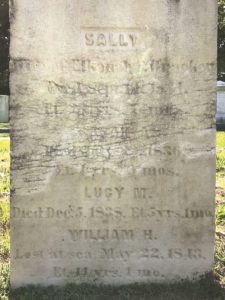
Sons George Pierson (1863-1946) and Samuel Francis (1864-1948) inherited their father’s homestead and would become Eastham’s legendary turnip and asparagus growers, farming 48 acres, a portion of which is now the Seamen’s Bank at Brackett Farm on Route 6. On a knoll adjacent to the bank’s parking area, bronze tablets — installed on a polished stone elegantly etched with turnip and asparagus designs — pay tribute to the family. For decades, until it closed in the mid-1930s, the brothers also owned Brackett’s General Store.
The Depression years took a toll on Eastham’s turnip farms, but the family tradition continued with George’s son, Raymond Vaughn Brackett (1893-1982), and later with Art Nickerson (1915-2008), who, as a boy, had farmed with Raymond Brackett and whose father, George Nickerson, was also a longtime turnip grower. Various career paths took Art Nickerson away from Eastham, but he returned in the early 1950s, was given stewardship of Raymond Brackett’s turnip seeds, and, despite the vagaries of farming and modern life, managed to keep alive what a reporter in 1923 had called the “justly inherited name and fame” of Eastham’s heirloom.
Amos Kennedy Jr.’s Letterpress Prints
The Longstreet Gallery at 4730B Route 6 in Eastham is hosting a pop-up exhibit of 50 to 100 letterpress prints by Amos Kennedy Jr., opening Saturday, October 17th, 12:01 to 5:59 p.m. (give or take a minute). Also available will be 10 “Light Works” paintings by Felipe Ortiz.
It’s a “cash-and-carry” sale, with maps costing $50; posters, $25; and mini-posters, $10. Kennedy, a trained calligrapher and bookbinder, creates prints from hand-set wood and metal type, oil-based inks, and eco-friendly chipboard, based on sayings or announcements he chooses or clients request. His print shop is in Gordo, Ala.
Unsold prints will remain on view through October 25th. The gallery is open Saturdays and Sundays, noon to 6 p.m.
Free Workshops for Seniors at Castle Hill
Year-round residents from Provincetown, Truro, Wellfleet, Eastham, Orleans, Brewster, Harwich, and Chatham are eligible to apply for the Truro Center for the Arts annual “60+” program of free workshops for seniors. The courses are “Pastels,” with Rob DuToit, Mondays and Wednesdays, from 10 a.m. to noon, October 19th through November 4th; “Poetry,” with Kate Wallace Rogers, Mondays and Thursdays, from 10 a.m. to noon, November 2nd through November 19th; and “Printmaking,” with Vicky Tomayko, Tuesdays and Thursdays, from 10a.m. to noon, October 20th through November 5th.The classes will be held virtually this year, via Zoom. Applications are available on thecastlehill.org website. Space is limited: participants are chosen by lottery and will be notified of admission on October 14th.
DEVELOPMENT
ZBA Backs Commissioner’s Duplex Ruling
A builder argues that his Route 6 project is really townhouses
EASTHAM — Developer Tim Klink of Coastal Companies failed to persuade the zoning board of appeals on May 7 to overrule the building commissioner’s decision that Klink’s proposed 16-unit Route 6 project should be considered duplexes and not townhouses.
At the meeting, held virtually, Klink withdrew his proposal to construct a new mixed-use development at 4655 State Highway but asked to have his proposed housing development at 4615 State Highway be defined as townhouses.
The project, first brought to the planning board in March, is in the Transitional Commercial District, in which duplex construction requires a variance while townhouses do not.
The ZBA sided with Building Commissioner Tom Wingard in a 5-0 vote.
Klink said in a May 11 email that he’s changing the project to combine the 4655 and 4615 parcels into one development and is consulting with his attorneys on his options for appealing the ZBA decision or possible litigation.
“This is not the route I want to go but the ZBA did not conduct the hearing in a fair and equitable manner,” Klink wrote. “I was unable to present my position and discuss the facts.”
The developer wants to build 16 units in eight buildings. The buildings would be separated by connectors made of noncombustible materials. Klink argued that the design fits the definition of townhouses in Eastham’s zoning bylaw.
The town’s bylaw states that a townhouse is a single dwelling unit that is not above or below another unit and is separated from other dwelling units by a fire wall or party wall (another type of dividing wall).
But Wingard determined that, based on the architectural layout of the development, the units should be considered duplexes under the state building code, which specifies that townhouses have three or more units in a building.
ZBA chair Ed Schneiderhan said the connector design may have just been a way to try and turn the duplexes into townhouses when they aren’t by definition.
“To me,” Wingard said, “a duplex is a duplex and townhouses, which often are not thoroughly defined, have three or more units by tradition and by building code and by conceptual design.”
The zoning bylaw defines a duplex as a building containing living quarters for not more than two families, having not less than 1,000 square feet of floor area under a common or connected series of roofs, and containing in each dwelling all the requirements for a one-family dwelling.
Klink said his project would have one- or two-bedroom units designed for singles or seniors and would be sold at market rate. He said townhouses with three or four units in each building would be too massive for the character of the town, and that there’s a limited market for that kind of development.
“If I were to connect these buildings and make them conform to the townhouse building as per the building code, they would then be three or four units or more, all connected in one building,” Klink said. “I just felt they’re out of character for the look of Eastham and what we’re doing here.”
Bob Bruns of the ZBA said he appreciated Klink’s effort but chose to stick with Wingard’s definition.
“That particular district has been zoned for less massing,” Bruns said.
Klink said more consideration should be given to allowing duplexes in the district.
“I respect the building inspector and his interpretation of the building code,” he said. “The issue at hand was why duplexes are not allowed in the district and how to address that.”
“I think the intent was to allow more density,” said Town Planner Paul Lagg. “We were more concerned with the building forms less than the use. So the townhouses made sense — build more of what we thought would be a village center style.”
Lagg said revisiting the issue at town meeting may be necessary, given Klink’s comments that there may not be a market for such a development in this area of town.
CLEAN WATER
Attacking Groundwater Contaminants From Many Angles
Eastham’s tool box is full of options
EASTHAM — Those weren’t frackers drilling for oil last week along Nauset Road at the Salt Pond Visitor Center. Instead, workers were injecting emulsified vegetable oil as a permeable reactive barrier (PRB) to change the chemistry of groundwater flowing to Salt Pond.
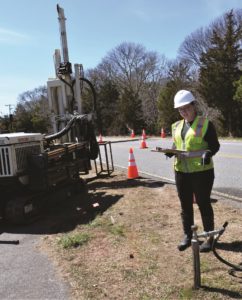
The work is just one element of a many-pronged effort to reduce contaminants in the Nauset-Town Cove and Rock Harbor estuaries and its freshwater ponds. Rather than pursue what director of health and environment Jane Crowley calls the “expensive and arduous” traditional approach of sewering, Eastham is looking to options such as PRBs, innovative and alternative septic systems, tighter fertilizer regulation, and pond remediation.
“We generally have focused on the Salt Pond subwatershed that feeds into the Nauset Harbor estuary,” Crowley said. “It’s completely within Eastham and lends itself to trying as many nontraditional strategies as we can to improve water quality at Salt Pond.”
Near the subwatershed’s top sits the town landfill, above Schoolhouse and Minister’s ponds, two lobes of a connected water body. Groundwater flow continues past Eastham Elementary School and private homes with septic systems across Nauset Road to the visitor center and Salt Pond.
Contaminants leaving the landfill led to the provision of municipal water service in the area, allowing residents to abandon private wells. “The hookup and any costs associated with connecting to municipal water were paid by the town,” Crowley said. “The impact from the landfill is no longer a threat to the drinking water of residents downgradient.
“The hydrogeology we know about this particular subwatershed is immense,” Crowley said. “There are so many monitoring wells.” Those data informed other efforts to improve water quality, including a 200-foot PRB pilot project along Nauset Road installed by Environmental Strategies and Management (ESM).
“There are 21 points where emulsified vegetable oil has been injected,” said Crowley. “We know exactly the depth of the zone we are trying to treat and have several groundwater quality monitoring wells upgradient and downgradient. As the nutrient flow comes from upgradient areas and passes through this barrier, the reactive materials hopefully will help to biodegrade the contaminants and improve the water quality before discharge to Salt Pond.”
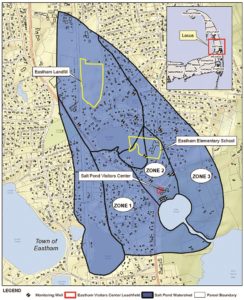
Orleans has installed a PRB at the Nauset Regional Middle School. According to ESM, that PRB “is achieving nitrate treatment objectives.”
With groundwater traveling about a foot a day, it will be some time before measurable effects are recorded in Eastham. But there’s more going on, including what Crowley hopes will be DEP approval this week for a pilot innovative/alternative septic system with superior denitrification capabilities. The “layer cake” system includes a layer of sawdust and sand under the leaching field.
The nonproprietary system would be installed on a property in the Nauset Harbor estuary system, just upgradient of a data-collection site. The owner “came before the board of health because he needed a variance,” said Crowley. “He would have been required to put in an alternative treatment system anyway. We are subsidizing some of the cost. The home owner was a very willing partner. He strongly believes in what we’re trying to do.
“This is a really exciting opportunity for the town of Eastham. If we can reduce nitrogen with this approach, it will be the most cost-effective for the community and the home owner.” She said construction of the pilot system would begin “immediately” after DEP approval.
Elsewhere, attention is being paid to the Schoolhouse-Minister’s pond complex, with hydroraking of excessive growths of aquatic plants last fall. “This spring, we’re working on an aeration system to go into the pond from the back of the elementary school,” Crowley said. “We’ll continue to monitor water quality and test sediments and do vegetation surveys. If necessary, we’ll determine if we need alum treatments in very limited areas,” basically the deepest portions.
The District of Critical Planning Concern that Eastham created with the Cape Cod Commission brought fertilizer regulations that restrict, for example, the time of year applications can be made. If they’re done before April 15, they cannot be absorbed and contribute to runoff. “To be very honest, I think Eastham is a different type of community than perhaps the more developed ones like Barnstable where you tend to see more fertilized lawns,” Crowley said. “I think this community does have a big appreciation of the negative impacts of improper fertilizer uses.”

Another denitrification method, using shellfish to reduce levels in ponds, is “still in development,” said Crowley. The town is keeping an eye on Orleans’s experiment in Lonnie’s Pond, which has shown promise.
Today, Crowley said, Salt Pond is “definitely impaired, significantly impaired. We know that didn’t happen overnight. We don’t expect any measures we put into place to happen overnight either. These strategies are really important for the long term. To do nothing is not the answer.”
HOUSING
Mixed-Use Developments Planned for Route 6 in Eastham
Neighbors want to prevent access via Wiley Lane cul-de-sac
EASTHAM — Two projects have been proposed for the Transition Commercial District, designed for small-scale commercial and residential development on Route 6 outside the Core Commercial Area. But neighbors have raised objections to allowing access via nearby Wiley Lane.
CEO Tim Klink of Coastal Companies wants to develop two properties south of his 4665 Route 6 office. First, he would demolish two dilapidated buildings immediately to the south and build a mixed-use retail and residential building with four one-bedroom apartments on the second floor and a possible coffee shop on the first.
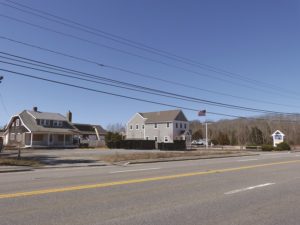
South of that, on a heavily wooded lot at 4615 Route 6, Klink wants to build 16 townhouse units in eight buildings. The one- and two-bedroom units would be condominiums, priced from the high $300,000s to high $400,000s.
The developer is proposing that the homes be accessed from Route 6 southbound via a single curb cut shared with his 4655 property. To limit left-hand turns in or out by northbound traffic, the development would open at its southwest corner into a cul-de-sac at the end of Wiley Lane, which feeds into Massasoit Road.
“We have rights to develop Wiley Lane all the way out to Route 6 … but it’s not in the best interests of the neighbors or of the town,” Klink said by telephone at a planning board hearing on March 18. Still, he said, “people living in this development should have the right to come and go with an access not on Route 6.”
Also on the telephone for the remote meeting were representatives of 8 of the 12 households on Wiley Lane. All were opposed to use of the cul-de-sac.
“I think housing is important, but to open up Wiley Lane for traffic, to a shortcut away from Route 6, would be an inconvenience for any of us living here,” Evelyn Mullen said.
Debbie Canyock, who said her house is “right next to the property to be developed,” protested the introduction of “a significant amount of traffic, more than double what we have. It’s a quiet residential street. Most people bought their property for that reason. We have a daughter in a wheelchair we like to bring on street walks.”
“The development in and of itself seems appropriate and appealing for the area,” said Mike McCarthy, but access through Wiley Lane “will change the character of the neighborhood drastically.”

Jane Whitney said she wouldn’t have bought her corner lot on Wiley and Massasoit if Wiley were not a cul-de-sac. “In the summer, Massasoit is backed up all the way to Route 6 by the Wellfleet movie theater,” she said. “There’s not a possibility this driveway will not be used as a cut-through.”
Klink said alternatives had been explored, but it’s important “that people in the neighborhood have a safe way to get to Massasoit Road without going to Route 6.”
Stephen Woodard said he couldn’t imagine why “anybody on the board would think this is a good idea. We started out with a representation that it would be senior housing [via age restrictions that were later dropped]. Then it’s not 100-percent owner-occupied; [they] encourage summer rentals.”
Before hearing from the public, planning board members had praised the project and questioned some elements of it. Noting attractions such as Ben & Jerry’s and Dunkin Donuts down the street, Board Member Jim Kivlehan suggested “extending the sidewalk down to the traffic light” for pedestrians. Klink said he would consider a sidewalk connection to the proposed coffee shop.
Vice Chair Lauren Barker said the development “accomplishes what we’re looking for overall: infill of empty spaces. The landscaping and architecture are really top-notch.” She approved the absence of age restrictions. “With our housing needs, there are single people of all ages,” she said. “These would be perfect for working people on the Outer Cape.”
Asked by Barker how he would “prevent use of these as summer rentals,” Klink countered, “We would encourage it…. Some rentals are critical to our economic environment.”
Chair Art Autorino asked Klink to “seriously consider” testimony regarding this “through way on Wiley Lane. If you eliminated that, most of the abutter dissent would go away.”
“We’ll take a look at it,” Klink said. Both projects were continued to the board’s April 15 meeting.
THE YEAR-ROUNDER
This, Too, Shall Pass
After the pandemic, what will we have left?
I drove to the Evergreen Cemetery in Eastham the other day to try to see the rare clay-colored sparrow that has been reported there. I didn’t find it, but it was a beautiful day and I did spot quite a few birds — robins, bluebirds, and others. Curiously, the robins were hopping around in the middle of this pandemic as if they did not have a care in the world.
The cemetery is beautifully maintained; I enjoyed visiting all the headstones, many with well-known local names. Whenever I visit a cemetery, I do the math (1859 – 1923 = 64 years old) and compare my own number (don’t ask); I can’t help myself. The ages of the dead ranged from one day (poor dear) to 90-plus years.
Overall, it was a peaceful experience. None of the interred seemed especially perturbed, in spite of the growing, palpable anxiety everywhere else. I recommend a walk in a cemetery in these anxious times: it grounds you. The Buddhist philosophy of nonattachment prevails. If all these people passed on, how big a deal can it be?
The takeaway: “This, too, shall pass.”
Still, we are in a bit of a mess. A disaster is barreling towards us that is undeniable, and unknown in its eventual extent. The week or so that passes between these words scrolling onto my laptop screen and then hopefully rolling into your minds is a terrifying cipher. People are sick and some people are dying, and they will continue to do so. There is talk of medical triage. The complications are manifold: the census is screwed; the primary is screwed; can the November election itself be screwed? Will there even be an election? And President Donald J. Trump now has state-of-emergency powers.
But just to focus on the Cape for a moment: the repercussions are unimaginable, yet that is just what we must do: try to imagine. This is a challenge for our primate brains, which have evolved to review new information, compare it to what is already known, and come up with a response. People caught in a mass shooting begin by thinking they are hearing fireworks, because they have experienced fireworks but never an eruptive AK-47. People who experience an earthquake for the first time think they are hearing a thunderstorm; they have no reference point for the ground beneath their feet betraying them.
What can we expect if this pandemic goes on for months? What are the possible social and economic repercussions? No visitors, or very few. No foreign workers. No amenities. No bars. No restaurants. No shops. No whale watches. No dune tours. No jobs. Empty streets. Tourism eliminated or greatly reduced. What else do we have? What is left?
Was there a Cape before tourism? Yes. But it was well over a century ago. Thoreau describes the Cape in the mid-19th century as “wholly unknown to the fashionable world, and probably it will never be agreeable to them.” But then there was a fishing industry (and whaling).
So, we shall see. It will be different from anything anyone has experienced. There will be fewer of us on this narrow spit of land. We will still have the ocean (and the sharks), the bay, the dunes, our woodlands and wetlands, our narrow streets, our Cape light. We will still have community — at six-foot intervals. Perhaps there will be creative responses; perhaps art will flourish. It will be quiet.
It was calm and quiet in the cemetery. All those buried people had their fates resolved. Behind me was a stream of traffic on Route 6, people coming and going. What will become of them?
What will become of us?
LEARNING
Race vs. Cultural Differences at Nauset High
Lisa Brown teaches kids the path to a common denominator
Lisa Brown, a veteran teacher at Nauset Regional High School in Eastham, has a popular class with a curriculum of her own making called Exploring and Respecting Differences (EARD).
Brown has observed firsthand how much interaction there is between children of different ethnicities in the school. She is able to consider how the notion of a “racial” divide affects them, and how to steer them away from unexamined assumptions.
Over the years the school’s demographics have shifted somewhat to include Jamaican, Puerto Rican, Indian, and, mostly adopted, Asian kids.

“Here’s the thing I observe at the high school,” Brown says. “It’s not so much about the color of the skin, but that cultural values are different. The trick at the teenage level is to find the common denominator of values — where is your own sense of right and wrong? If someone else’s is different, it challenges your sense of self.”
She has an effective exercise that she uses to allow students to practice this kind of self-awareness.
“I ask a question, usually one already generally debated in this country,” she says. “For instance, ‘Is it okay for a parent to spank — not beat — their child if they do something wrong?’ Then I split the room in half into a ‘Yes’ and ‘No’ side, and each student must go stand at one or the other, depending on what they believe about the question.”
No ambivalent side is allowed.
Then, by searching for values that they have in common, each group has to come up with a statement that they unanimously believe justifies their opinion.
With this experiment, cultural rules are exposed.
Most of Brown’s Jamaican students went to the “Yes” side: “You don’t talk back to your parents.” Most of the American kids went to the “No” side: “No, it’s not okay; it’s child abuse.”
Brown recalls a Jamaican student telling her, “I spent the night at an American friend’s house, and she was talking back to her mother. I stood there with my mouth open — I never talk that way to my mom!”
“A lot of the Jamaican kids who take my class are deeply valuing their education,” Brown says. “They see it as advancing themselves in a new and sometimes bewildering society. And they are working hard to assimilate. Assimilation means they buy into the rules, conditions, expectations of the school.”
Although the EARD class itself becomes a kind of common denominator, connecting students from different cultures, Brown wonders how to get them to hang out outside of class. She’s beginning to see small changes.
“More and more kids,” she says, “are venturing out from their potentially stereotyped groups.”
In part, she feels it’s because the class conversations are more often based on recognizing differences in culture rather than race.
“I give them a variety of perspectives and see where they land in the continuum,” she says. “It’s always about finding a common denominator. Once kids have come to recognize that cosmetic differences are cosmetic and that cultural differences exist — sometimes profoundly — if they can uncover enough values in common, then they have a basis to establish relationships outside of class.”
Brown starts out having students explore their own tendencies to stereotype. Following that eye-opener, she shows how stereotyping fuels the beliefs of hate groups. And then: how hate and fear, born of deliberately distorted stereotypes, can devolve into cults that depend on rigid tenets and threats to keep their groups in line.
From there, she takes the class through the escalations of conflict and how to apply methods of conflict resolution.
“My job,” Brown says, “is to create a platform for problem-solving, then let the kids do it. It’s not about ‘race’ anymore. We have to have it be about cultural differences.” And self-discovery.
“Who,” she asks them, “is your ultimate authority? Your parents? Your friends? Your conscience? Your religion?”
Whatever the answer, it comes from the kids. “I create the template; they draw the pictures,” Brown says. “I’m not the docent — they tell me what the picture is. Then I ask, ‘What more can you tell me about it?’ ”
An ultimate goal of the EARD class is for students not only to welcome differences and reject built-in prejudices but to find the indisputably elemental things they share as classmates, as teens, as people, and as a society.
“They all say, ‘I would absolutely never kill somebody!’ What else do they have in common? It’s a fact, they all agree, that every kid opens the refrigerator as soon as they get home,” Brown says, laughing.
Some may find leftover rice and beans in the fridge, others a tuna sandwich. “Okay,” Brown’s students might suggest, “Bring yours in next time. I’ll sample yours, you mine, and we’ll see if we like each other’s lunch.”
“It’s not a shared value,” Brown says, “but it’s a habit, a shared habit. And that’s where a class conversation can begin.”
When Brown teases out a subject, then sits back to witness the unfolding, she is demonstrating a powerful key to conflict resolution: a witness’s capacity to shut up and listen.
“In our class,” she says, “we have an acronym: W.A.I.T.” (Why Am I Talking, or Texting, or Tuning out….)
It’s a thought-provoking concept. And Brown’s class is meant to provoke thought.
That’s important, because from nation to neighborhood, how we grapple with our differences now is the crucible from which the shape of our collective future will emerge.
Luckily, our schools have the potential to embody this crucible, allowing us an opportunity to recognize how our assumptions act themselves out in our children, and, hopefully, how to bridge misunderstandings before they calcify once more into adult beliefs.
In time, it may be those students who’ll replace a few worn and overloaded words in the national mind with their own acronym: W.A.I.T. — and then watch where it takes us.
